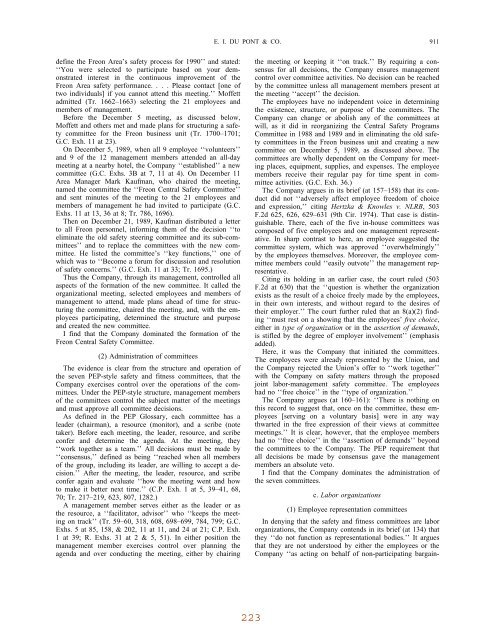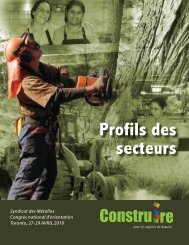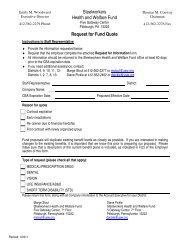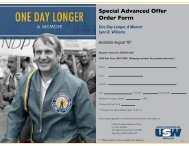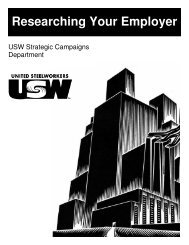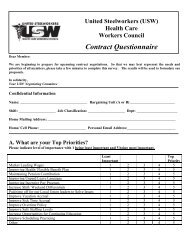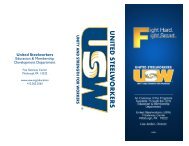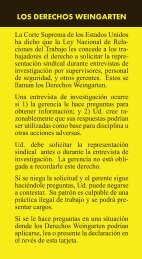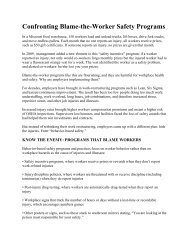Union Approach to Health and Safety: - United Steelworkers
Union Approach to Health and Safety: - United Steelworkers
Union Approach to Health and Safety: - United Steelworkers
You also want an ePaper? Increase the reach of your titles
YUMPU automatically turns print PDFs into web optimized ePapers that Google loves.
E. I. DU PONT & CO.<br />
911<br />
define the Freon Area’s safety process for 1990’’ <strong>and</strong> stated:<br />
‘‘You were selected <strong>to</strong> participate based on your demonstrated<br />
interest in the continuous improvement of the<br />
Freon Area safety performance. . . . Please contact [one of<br />
two individuals] if you cannot attend this meeting.’’ Moffett<br />
admitted (Tr. 1662–1663) selecting the 21 employees <strong>and</strong><br />
members of management.<br />
Before the December 5 meeting, as discussed below,<br />
Moffett <strong>and</strong> others met <strong>and</strong> made plans for structuring a safety<br />
committee for the Freon business unit (Tr. 1700–1701;<br />
G.C. Exh. 11 at 23).<br />
On December 5, 1989, when all 9 employee ‘‘volunteers’’<br />
<strong>and</strong> 9 of the 12 management members attended an all-day<br />
meeting at a nearby hotel, the Company ‘‘established’’ a new<br />
committee (G.C. Exhs. 3B at 7, 11 at 4). On December 11<br />
Area Manager Mark Kaufman, who chaired the meeting,<br />
named the committee the ‘‘Freon Central <strong>Safety</strong> Committee’’<br />
<strong>and</strong> sent minutes of the meeting <strong>to</strong> the 21 employees <strong>and</strong><br />
members of management he had invited <strong>to</strong> participate (G.C.<br />
Exhs. 11 at 13, 36 at 8; Tr. 786, 1696).<br />
Then on December 21, 1989, Kaufman distributed a letter<br />
<strong>to</strong> all Freon personnel, informing them of the decision ‘‘<strong>to</strong><br />
eliminate the old safety steering committee <strong>and</strong> its sub-committees’’<br />
<strong>and</strong> <strong>to</strong> replace the committees with the new committee.<br />
He listed the committee’s ‘‘key functions,’’ one of<br />
which was <strong>to</strong> ‘‘Become a forum for discussion <strong>and</strong> resolution<br />
of safety concerns.’’ (G.C. Exh. 11 at 33; Tr. 1695.)<br />
Thus the Company, through its management, controlled all<br />
aspects of the formation of the new committee. It called the<br />
organizational meeting, selected employees <strong>and</strong> members of<br />
management <strong>to</strong> attend, made plans ahead of time for structuring<br />
the committee, chaired the meeting, <strong>and</strong>, with the employees<br />
participating, determined the structure <strong>and</strong> purpose<br />
<strong>and</strong> created the new committee.<br />
I find that the Company dominated the formation of the<br />
Freon Central <strong>Safety</strong> Committee.<br />
(2) Administration of committees<br />
The evidence is clear from the structure <strong>and</strong> operation of<br />
the seven PEP-style safety <strong>and</strong> fitness committees, that the<br />
Company exercises control over the operations of the committees.<br />
Under the PEP-style structure, management members<br />
of the committees control the subject matter of the meetings<br />
<strong>and</strong> must approve all committee decisions.<br />
As defined in the PEP Glossary, each committee has a<br />
leader (chairman), a resource (moni<strong>to</strong>r), <strong>and</strong> a scribe (note<br />
taker). Before each meeting, the leader, resource, <strong>and</strong> scribe<br />
confer <strong>and</strong> determine the agenda. At the meeting, they<br />
‘‘work <strong>to</strong>gether as a team.’’ All decisions must be made by<br />
‘‘consensus,’’ defined as being ‘‘reached when all members<br />
of the group, including its leader, are willing <strong>to</strong> accept a decision.’’<br />
After the meeting, the leader, resource, <strong>and</strong> scribe<br />
confer again <strong>and</strong> evaluate ‘‘how the meeting went <strong>and</strong> how<br />
<strong>to</strong> make it better next time.’’ (C.P. Exh. 1 at 5, 39–41, 68,<br />
70; Tr. 217–219, 623, 807, 1282.)<br />
A management member serves either as the leader or as<br />
the resource, a ‘‘facilita<strong>to</strong>r, advisor’’ who ‘‘keeps the meeting<br />
on track’’ (Tr. 59–60, 318, 608, 698–699, 784, 799; G.C.<br />
Exhs. 5 at 85, 158, & 202, 11 at 11, <strong>and</strong> 24 at 21; C.P. Exh.<br />
1 at 39; R. Exhs. 31 at 2 & 5, 51). In either position the<br />
management member exercises control over planning the<br />
agenda <strong>and</strong> over conducting the meeting, either by chairing<br />
the meeting or keeping it ‘‘on track.’’ By requiring a consensus<br />
for all decisions, the Company ensures management<br />
control over committee activities. No decision can be reached<br />
by the committee unless all management members present at<br />
the meeting ‘‘accept’’ the decision.<br />
The employees have no independent voice in determining<br />
the existence, structure, or purpose of the committees. The<br />
Company can change or abolish any of the committees at<br />
will, as it did in reorganizing the Central <strong>Safety</strong> Programs<br />
Committee in 1988 <strong>and</strong> 1989 <strong>and</strong> in eliminating the old safety<br />
committees in the Freon business unit <strong>and</strong> creating a new<br />
committee on December 5, 1989, as discussed above. The<br />
committees are wholly dependent on the Company for meeting<br />
places, equipment, supplies, <strong>and</strong> expenses. The employee<br />
members receive their regular pay for time spent in committee<br />
activities. (G.C. Exh. 36.)<br />
The Company argues in its brief (at 157–158) that its conduct<br />
did not ‘‘adversely affect employee freedom of choice<br />
<strong>and</strong> expression,’’ citing Hertzka & Knowles v. NLRB, 503<br />
F.2d 625, 626, 629–631 (9th Cir. 1974). That case is distinguishable.<br />
There, each of the five in-house committees was<br />
composed of five employees <strong>and</strong> one management representative.<br />
In sharp contrast <strong>to</strong> here, an employee suggested the<br />
committee system, which was approved ‘‘overwhelmingly’’<br />
by the employees themselves. Moreover, the employee committee<br />
members could ‘‘easily outvote’’ the management representative.<br />
Citing its holding in an earlier case, the court ruled (503<br />
F.2d at 630) that the ‘‘question is whether the organization<br />
exists as the result of a choice freely made by the employees,<br />
in their own interests, <strong>and</strong> without regard <strong>to</strong> the desires of<br />
their employer.’’ The court further ruled that an 8(a)(2) finding<br />
‘‘must rest on a showing that the employees’ free choice,<br />
either in type of organization or in the assertion of dem<strong>and</strong>s,<br />
is stifled by the degree of employer involvement’’ (emphasis<br />
added).<br />
Here, it was the Company that initiated the committees.<br />
The employees were already represented by the <strong>Union</strong>, <strong>and</strong><br />
the Company rejected the <strong>Union</strong>’s offer <strong>to</strong> ‘‘work <strong>to</strong>gether’’<br />
with the Company on safety matters through the proposed<br />
joint labor-management safety committee. The employees<br />
had no ‘‘free choice’’ in the ‘‘type of organization.’’<br />
The Company argues (at 160–161): ‘‘There is nothing on<br />
this record <strong>to</strong> suggest that, once on the committee, these employees<br />
[serving on a voluntary basis] were in any way<br />
thwarted in the free expression of their views at committee<br />
meetings.’’ It is clear, however, that the employee members<br />
had no ‘‘free choice’’ in the ‘‘assertion of dem<strong>and</strong>s’’ beyond<br />
the committees <strong>to</strong> the Company. The PEP requirement that<br />
all decisions be made by consensus gave the management<br />
members an absolute ve<strong>to</strong>.<br />
I find that the Company dominates the administration of<br />
the seven committees.<br />
c. Labor organizations<br />
(1) Employee representation committees<br />
In denying that the safety <strong>and</strong> fitness committees are labor<br />
organizations, the Company contends in its brief (at 134) that<br />
they ‘‘do not function as representational bodies.’’ It argues<br />
that they are not unders<strong>to</strong>od by either the employees or the<br />
Company ‘‘as acting on behalf of non-participating bargain-


